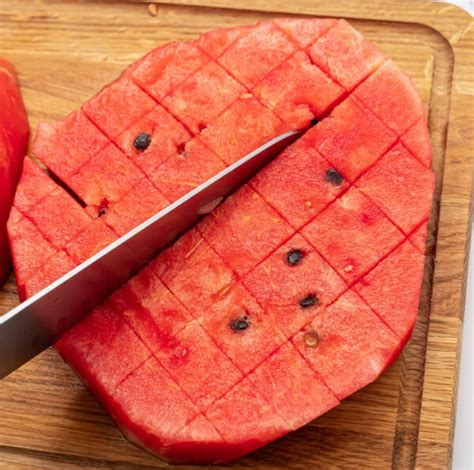
A food editor has revealed a simple method for slicing watermelon, allowing for quick and easy serving. The technique involves halving the melon, placing one half flat-side down, and making vertical and horizontal cuts to create easily manageable sticks, a method touted for its speed and efficiency.
Forget struggling with unwieldy watermelon slices. According to food editor Justin Sullivan, there’s a faster, cleaner way to enjoy this summer fruit. Sullivan shared his method in a recent article, detailing a process that transforms a whole watermelon into ready-to-eat sticks in mere seconds. This technique promises to eliminate the sticky mess and cumbersome slices often associated with enjoying watermelon.
The core of Sullivan’s method lies in strategic cutting. First, the watermelon is halved. One half is then placed flat-side down on a cutting board for stability. Next, vertical cuts are made across the melon, followed by horizontal cuts, creating a grid pattern. The result is a collection of evenly sized watermelon sticks, perfect for snacking or serving.
“The easiest way to cut a watermelon, according to Sullivan, is to slice it into sticks,” the article states. This approach maximizes efficiency and minimizes the amount of rind attached to each piece, offering a more palatable experience.
The method is designed to be user-friendly for individuals of all skill levels. Sullivan emphasizes that the most important aspect is having a sharp knife to ensure clean, even cuts. This not only makes the process safer but also contributes to the overall presentation of the watermelon sticks.
Beyond its simplicity, Sullivan’s technique offers several advantages. The stick format is ideal for children, providing a handle for easy gripping. It also simplifies serving at gatherings, allowing guests to grab and go without the need for additional cutting or preparation. The consistent size of the sticks also makes portion control easier, which can be a benefit for those watching their sugar intake.
The traditional method of slicing watermelon often involves cutting large, triangular wedges, which can be messy and difficult to eat. The rind can be thick and cumbersome, and the juice tends to drip easily. Sullivan’s stick method addresses these issues by reducing the amount of rind per serving and creating a more manageable shape.
Furthermore, the even distribution of watermelon flesh in the stick format ensures that each bite is consistently sweet and juicy. This contrasts with wedge-shaped slices, where the sweetness can vary depending on the location of the cut.
The ease and efficiency of Sullivan’s method have resonated with many home cooks and food enthusiasts. Social media platforms have been flooded with users sharing their own experiences with the technique, often accompanied by photos and videos showcasing the neatly cut watermelon sticks.
The shift towards simpler, more practical food preparation methods reflects a broader trend in culinary culture. Busy lifestyles and a growing emphasis on healthy eating have fueled the demand for recipes and techniques that are both time-saving and nutritious. Sullivan’s watermelon hack aligns perfectly with these trends, offering a convenient way to enjoy a naturally sweet and hydrating fruit.
Watermelon is not only delicious but also packed with essential nutrients. It is a good source of vitamins A and C, as well as antioxidants like lycopene. Lycopene has been linked to a reduced risk of certain types of cancer and cardiovascular disease. Watermelon is also low in calories and high in water content, making it an excellent choice for hydration, especially during hot summer months.
The versatility of watermelon extends beyond simple snacking. It can be used in a variety of culinary applications, from salads and smoothies to grilled dishes and refreshing beverages. The stick format created by Sullivan’s method makes it particularly well-suited for adding to fruit platters or incorporating into creative appetizers.
Experimenting with different variations of the watermelon stick format can further enhance the culinary experience. For example, the sticks can be drizzled with honey or lime juice for added flavor. They can also be sprinkled with sea salt or chili powder for a sweet and savory twist. The possibilities are endless, limited only by one’s imagination.
The popularity of Sullivan’s watermelon hack underscores the importance of innovative thinking in the culinary world. By reimagining traditional food preparation methods, chefs and food editors can inspire home cooks to embrace new techniques and create more enjoyable culinary experiences. This, in turn, can lead to a greater appreciation for fresh, healthy ingredients and a more sustainable approach to food consumption.
As the summer season approaches, Sullivan’s watermelon hack is likely to become a go-to method for enjoying this quintessential summer fruit. Its simplicity, efficiency, and versatility make it an appealing option for anyone looking to elevate their watermelon game.
The original article also touched on the importance of selecting a ripe watermelon. Sullivan recommends looking for a watermelon with a dull rind and a yellow spot on the underside, which indicates that it has ripened in the field. The watermelon should also feel heavy for its size, which suggests that it is full of juicy flesh.
Proper storage of watermelon is also crucial for maintaining its freshness and flavor. Whole watermelons can be stored at room temperature for up to two weeks. Once cut, watermelon should be wrapped tightly in plastic wrap and stored in the refrigerator for up to five days.
In addition to the stick method, there are other creative ways to cut and serve watermelon. For example, watermelon can be scooped into balls using a melon baller, which is ideal for adding to fruit salads or cocktails. It can also be cut into cubes and used in salsas or gazpachos.
Watermelon rinds can also be used in culinary applications. They can be pickled, candied, or used to make jams and chutneys. This helps to reduce food waste and adds a unique flavor dimension to these dishes.
The growing popularity of watermelon has led to the development of numerous watermelon-based products, including juices, candies, and even beauty products. This reflects the versatility of the fruit and its appeal to a wide range of consumers.
The health benefits of watermelon extend beyond its vitamin and antioxidant content. It is also a good source of potassium, which is important for maintaining healthy blood pressure. Watermelon also contains citrulline, an amino acid that may help to improve athletic performance.
Choosing sustainable and ethically sourced watermelons is an important consideration for environmentally conscious consumers. Look for watermelons that are grown locally and harvested using sustainable farming practices. This helps to reduce the carbon footprint associated with transportation and supports local farmers.
The cultural significance of watermelon varies across different regions of the world. In some cultures, it is considered a symbol of abundance and prosperity. In others, it is associated with summer and outdoor gatherings.
The history of watermelon dates back thousands of years. It is believed to have originated in Africa and was later introduced to other parts of the world. Today, watermelon is grown in a variety of climates and is enjoyed by people of all ages.
Sullivan’s watermelon hack is just one example of the many ways in which food professionals are innovating and simplifying culinary techniques. By sharing these tips and tricks, they are empowering home cooks to create delicious and healthy meals with ease.
The impact of social media on food trends cannot be overstated. Platforms like Instagram and TikTok have become powerful tools for showcasing new recipes and techniques, often reaching a global audience in a matter of hours. This has led to a rapid dissemination of culinary knowledge and a greater appreciation for food culture.
The future of food preparation is likely to be shaped by a combination of technology and tradition. New kitchen gadgets and appliances are constantly being developed to automate and streamline cooking processes. At the same time, there is a growing emphasis on preserving traditional cooking methods and recipes.
Sullivan’s watermelon hack represents a perfect blend of these two trends. It is a simple, low-tech technique that is inspired by traditional culinary principles. Its widespread adoption is a testament to its effectiveness and its appeal to a modern audience.
In conclusion, Justin Sullivan’s watermelon slicing method offers a practical and efficient way to enjoy this summer fruit. Its simplicity, versatility, and health benefits make it a valuable addition to any home cook’s repertoire. By embracing this innovative technique, individuals can elevate their watermelon game and create more enjoyable culinary experiences.
Frequently Asked Questions (FAQ):
1. What is the main benefit of the food editor’s watermelon hack?
The primary benefit of the watermelon hack is its speed and efficiency. The method allows you to slice a watermelon into easily manageable sticks in a fraction of the time compared to traditional methods, minimizing mess and maximizing convenience. It converts the watermelon to convenient sticks, great for kids and adults alike.
2. How does the watermelon cutting technique work?
The technique involves halving the watermelon, placing one half flat-side down on a cutting board, making vertical cuts, followed by horizontal cuts to create a grid pattern, which results in watermelon sticks.
3. What tools are needed to perform this watermelon hack?
The only essential tool needed is a sharp knife. A cutting board is also recommended for stability and safety.
4. Is this method suitable for children to eat watermelon?
Yes, the stick format is particularly well-suited for children as it provides a handle for easy gripping, making it less messy and more convenient for them to eat.
5. How should I store the watermelon sticks after cutting them?
After cutting the watermelon into sticks, they should be wrapped tightly in plastic wrap or stored in an airtight container and refrigerated for up to five days to maintain freshness.
Expanded Context and Analysis:
The ingenuity of Justin Sullivan’s watermelon hack lies not just in its simplicity, but also in its address of several common pain points associated with watermelon consumption. Traditionally, slicing a watermelon involves wrestling with its size and shape, often resulting in uneven slices, sticky hands, and a significant amount of wasted rind. This method transforms the experience into something far more manageable and enjoyable.
One of the key advantages of the stick format is its improved portability. Watermelon is often enjoyed at picnics, barbecues, and other outdoor gatherings. The stick format makes it easy to pack and transport, eliminating the need for cumbersome containers or messy handling. This makes it a more practical choice for on-the-go snacking.
Furthermore, the stick format encourages mindful eating. Because each stick is a pre-portioned serving, it is easier to control the amount of watermelon consumed. This can be particularly beneficial for individuals who are watching their sugar intake or trying to maintain a healthy weight. Watermelon, while naturally sweet and nutritious, does contain sugar, so portion control is still important.
The reduction in rind per serving is another significant benefit. The rind of the watermelon, while edible, is not typically enjoyed due to its tough texture and bland flavor. The stick format minimizes the amount of rind attached to each piece, ensuring that each bite is primarily focused on the sweet, juicy flesh.
From a culinary perspective, the watermelon sticks offer a versatile canvas for experimentation. They can be paired with a variety of dips and toppings, from sweet honey and lime juice to savory sea salt and chili powder. They can also be incorporated into more complex dishes, such as salads, skewers, and appetizers.
The success of Sullivan’s watermelon hack highlights the power of social media in shaping food trends. The widespread sharing of the technique on platforms like Instagram and TikTok has contributed to its rapid adoption by home cooks around the world. This demonstrates the potential of social media to democratize culinary knowledge and empower individuals to create more enjoyable food experiences.
The underlying principles of Sullivan’s hack can be applied to other fruits and vegetables as well. The focus on simplicity, efficiency, and portability can be used to develop new cutting and serving techniques for a wide range of produce. This could lead to a broader trend towards more convenient and accessible ways to enjoy fresh, healthy foods.
The environmental impact of food preparation is also an important consideration. By reducing food waste and promoting sustainable practices, chefs and food editors can play a role in creating a more environmentally friendly food system. Sullivan’s watermelon hack, by minimizing the amount of wasted rind, contributes to this effort.
The evolution of culinary techniques is a continuous process, driven by innovation, experimentation, and a desire to improve the dining experience. Sullivan’s watermelon hack is a testament to this ongoing evolution, demonstrating how even the simplest of ideas can have a significant impact on the way we prepare and enjoy food.
The concept of “food hacks” has gained immense popularity in recent years, reflecting a growing demand for quick, easy, and creative solutions to common culinary challenges. These hacks often involve repurposing existing tools and techniques in unexpected ways, or simplifying complex recipes into more manageable steps.
The appeal of food hacks lies in their ability to empower home cooks to achieve professional-level results with minimal effort. They can also help to reduce stress and anxiety in the kitchen, making cooking a more enjoyable and rewarding experience.
However, it is important to approach food hacks with a critical eye. Not all hacks are created equal, and some may be unsafe or ineffective. It is essential to verify the accuracy and reliability of any food hack before attempting it, and to always prioritize food safety.
Sullivan’s watermelon hack, while simple and effective, is not without its limitations. It may not be suitable for all types of watermelons, particularly those with very thick rinds or uneven shapes. It may also require some practice to master, as the precision of the cuts is crucial for achieving the desired stick format.
Despite these limitations, the overall value of Sullivan’s watermelon hack is undeniable. It offers a practical and efficient way to enjoy this quintessential summer fruit, and it serves as a reminder that even the simplest of ideas can have a profound impact on our culinary lives.
The broader implications of this trend extend beyond the kitchen, highlighting the importance of creativity, innovation, and problem-solving in all aspects of life. By challenging conventional wisdom and seeking new ways to approach everyday tasks, we can unlock new possibilities and create a more fulfilling and enjoyable world.
The success of Justin Sullivan’s watermelon hack underscores the power of culinary innovation to transform the way we interact with food. By simplifying complex processes and making healthy eating more accessible, these innovations contribute to a more sustainable and enjoyable food culture. As we continue to embrace new techniques and technologies in the kitchen, we can look forward to a future where food preparation is both efficient and rewarding.
The hack isn’t just about the speed; it’s about the experience. The clean, uniform sticks provide a more appealing presentation, elevating the humble watermelon from a simple snack to a visually attractive treat. This attention to detail, even in the most basic of food preparation tasks, can significantly enhance the overall dining experience.
Consider the implications for catering and event planning. The ability to quickly and efficiently slice large quantities of watermelon into uniform sticks would be a major advantage for caterers, allowing them to serve a refreshing and attractive fruit option with minimal labor.
Furthermore, the stick format lends itself well to creative presentations. Watermelon sticks can be arranged in visually appealing patterns, skewered with other fruits and vegetables, or even used as edible garnishes. This versatility makes them a valuable asset for chefs and food stylists looking to add a touch of elegance to their dishes.
The health benefits of watermelon extend beyond its vitamin and antioxidant content. It is also a good source of electrolytes, which are essential for maintaining hydration. This makes watermelon an ideal choice for athletes and anyone engaging in strenuous physical activity.
The high water content of watermelon also contributes to its satiety effect, helping to curb cravings and promote weight management. This makes it a smart choice for individuals who are trying to eat healthier or lose weight.
The bright red color of watermelon is due to the presence of lycopene, a powerful antioxidant that has been linked to a reduced risk of certain types of cancer, including prostate cancer. Lycopene is also beneficial for cardiovascular health, helping to lower blood pressure and reduce the risk of heart disease.
The nutritional benefits of watermelon are maximized when it is consumed fresh and unprocessed. This is because the vitamins and antioxidants in watermelon can degrade over time when exposed to heat, light, or air.
Sullivan’s watermelon hack, by promoting the consumption of fresh watermelon, indirectly encourages healthier eating habits. The ease and convenience of the stick format make it more likely that individuals will choose watermelon as a snack or dessert option, rather than less healthy alternatives.
The ripple effect of this simple technique can extend to other areas of life as well. By embracing creativity and innovation in the kitchen, we can cultivate a mindset of problem-solving and resourcefulness that can be applied to other challenges and opportunities.
The act of cooking, even in its simplest forms, can be a therapeutic and mindful practice. It allows us to connect with our senses, express our creativity, and nourish ourselves and others.
Sullivan’s watermelon hack, by making food preparation more accessible and enjoyable, can encourage more people to embrace the art of cooking and experience its many benefits.
The cultural significance of watermelon is often overlooked, but it is a fruit that is deeply ingrained in the traditions and celebrations of many different cultures around the world.
In some cultures, watermelon is considered a symbol of good luck and prosperity. It is often served at weddings, festivals, and other special occasions.
In other cultures, watermelon is associated with summer and outdoor gatherings. It is a staple at picnics, barbecues, and sporting events.
The flavor and texture of watermelon are also highly valued in many cuisines. It is used in a variety of dishes, from salads and smoothies to grilled dishes and desserts.
The versatility of watermelon makes it a valuable ingredient for chefs and home cooks alike. It can be paired with a wide range of flavors and textures, and it can be used in both sweet and savory dishes.
Sullivan’s watermelon hack, by making watermelon easier to prepare and serve, helps to preserve and celebrate the cultural significance of this beloved fruit.
The ongoing evolution of culinary techniques is a testament to the human desire to improve and innovate. By constantly seeking new ways to prepare and enjoy food, we can create a more delicious, healthy, and sustainable world.
Justin Sullivan’s watermelon slicing method is a prime example of how simple ideas can have a profound impact on our culinary experiences. By embracing this innovative technique, we can elevate our watermelon game and create more enjoyable meals for ourselves and others.









